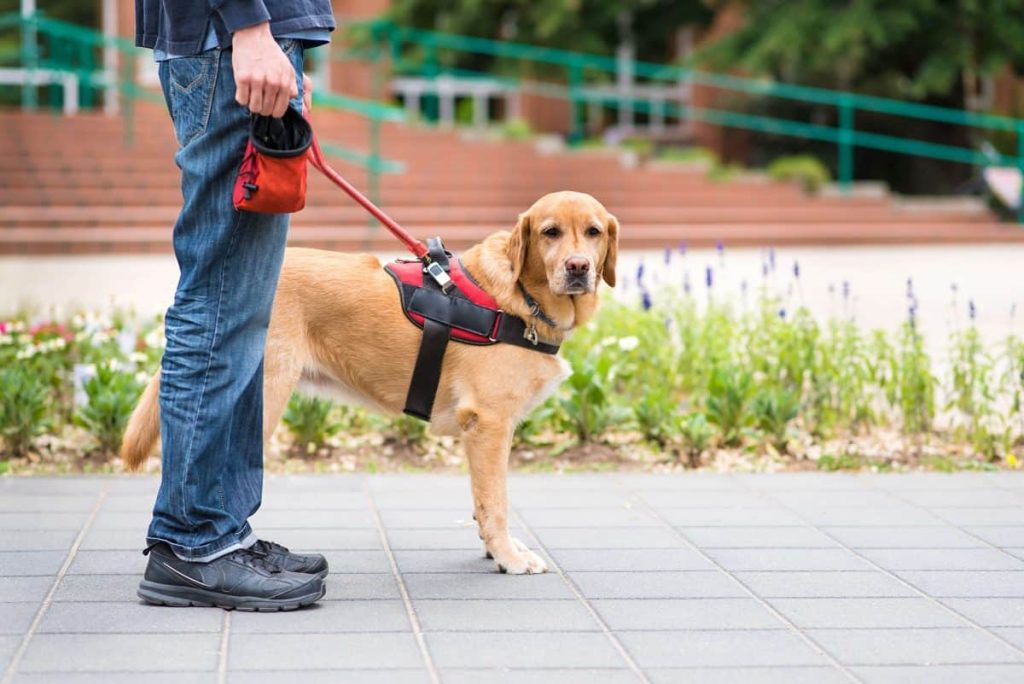Service Dog Breeds: The Vital Role in Assisting People with Disabilities

Understanding the Impact of Service Dogs
Every day, thousands of individuals across the United States face the challenges of living with disabilities. Service dogs play a crucial role in enhancing their quality of life by providing assistance in various ways. These highly trained companions not only offer support but also promote independence.
What Makes a Service Dog Special?
Service dogs are more than just pets; they are specially trained to cater to the unique needs of their handlers. Here are a few features that set them apart:
- Task-oriented skills: Service dogs perform specific tasks related to their handler’s disability. For example, guide dogs assist those who are visually impaired by navigating obstacles and ensuring their safety. Similarly, some dogs are trained to alert their handlers to sounds for individuals with hearing loss, such as alarms or doorbells.
- Emotional support: Beyond physical tasks, many service dogs provide crucial emotional support. Their presence can help reduce anxiety, panic attacks, and depression. For instance, individuals with post-traumatic stress disorder (PTSD) often find that the companionship of a service dog can be therapeutic, helping them regain a sense of stability and comfort in everyday life.
- Access to public spaces: Legally, service dogs are granted access to public spaces where regular pets are not allowed. This includes restaurants, public transportation, and stores, which is vital for a handler’s social integration and independence. The Americans with Disabilities Act (ADA) underscores these rights, allowing service dog teams to navigate public venues without obstacles.
Different breeds possess unique traits that make them ideal candidates for service work. For example, Golden Retrievers are known for their friendly demeanor and intelligence, making them excellent for therapy and guidance roles. German Shepherds, while also smart, are often chosen for their protective instincts and loyalty, commonly serving in roles that require more security. Understanding these breeds and their unique capabilities is essential in recognizing the profound impact they have on the lives of people with disabilities.
Discovering More About Service Dog Breeds
As we delve deeper into the world of service dog breeds, we will explore not only how these remarkable animals are trained but also the diverse functions they serve. Many programs across the United States are dedicated to breeding and training service dogs, such as Canine Companions for Independence and the Guide Dog Foundation for the Blind. These organizations utilize specific training protocols that prepare service dogs for the myriad challenges they may face in supporting their handlers.
This journey will not only celebrate their ability to transform lives but will also highlight the importance of understanding and supporting service dog initiatives. By fostering awareness and appreciation for these extraordinary animals, society can work toward a more inclusive environment where individuals with disabilities can thrive, enhancing their overall quality of life.

LEARN MORE: Click here for insights on balanced nutrition for your pet’s health
Key Breeds Making a Difference
When it comes to service dog breeds, not all dogs are created equal. Various breeds have distinct characteristics that lend themselves to specific tasks or environments. Understanding these breeds can shed light on how they are uniquely equipped to assist individuals with disabilities. Here, we explore some of the most popular service dog breeds, examining their traits and the roles they fill.
Golden Retrievers
Golden Retrievers consistently rank among the top breeds for service work. Known for their friendly and gentle nature, they easily establish a bond with their handlers, making them ideal therapy dogs. Their intelligence and trainability allow them to learn a variety of tasks, from guiding the visually impaired to assisting individuals with mobility challenges. Furthermore, their natural inclination to please makes them eager learners, increasing their effectiveness in various roles.
German Shepherds
Another prominent breed in the service dog arena is the German Shepherd. Renowned for their intelligence and loyalty, German Shepherds are often utilized in search and rescue, police work, and military roles. In the context of service dogs, their protective instincts make them excellent companions for individuals with disabilities who may require a heightened sense of security. Their size and strength can assist in physical tasks, such as pulling a wheelchair or providing balance support.
Labrador Retrievers
Labrador Retrievers are also among the most sought-after service dog breeds due to their versatility and amiable temperament. These dogs are known for their calm demeanor and strong work ethic, making them suitable for a variety of service roles, including guide dogs and assistance dogs for individuals with mobility impairments. Labs are particularly effective at alerting their handlers to sounds while providing a sense of comfort and companionship throughout daily activities.
Standard Poodles
While often overlooked in the service dog conversation, Standard Poodles are exceptional candidates for assistance work. Their high intelligence and hypoallergenic coat make them ideal for individuals with allergies. Poodles excel in task-oriented roles, such as guiding or helping with mobility, thanks to their agility and adaptability. Additionally, their friendly nature allows them to connect easily with people, providing emotional support alongside physical assistance.
Other Breeds to Consider
Although the aforementioned breeds dominate the service dog landscape, other breeds like Boxers, Doberman Pinschers, and Cavalier King Charles Spaniels are also making strides in assistance roles. Each breed has its unique capabilities that cater to specific needs, highlighting the importance of tailored training and support for individuals requiring assistance.
Understanding these service dog breeds offers insight into the vital roles they play in enhancing the lives of people with disabilities. By recognizing their unique attributes and functions, we can appreciate their impact and the essential bond they share with their handlers.
When considering the service dog breeds, it is essential to understand the specific attributes that make these dogs invaluable companions for individuals with disabilities. Some breeds have been recognized for their unique abilities and temperament, contributing significantly to the daily lives of those they assist. Below is a table outlining the critical advantages of select breeds commonly trained as service dogs.
| Service Dog Breed | Advantages |
|---|---|
| Labrador Retriever | Known for their friendly demeanor and intelligence, making them ideal for training. |
| German Shepherd | Highly versatile, providing support in mobility and medical alert tasks. |
| Golden Retriever | Exceedingly gentle and patient, commonly used for therapy assistance. |
| Border Collie | Exceptional problem-solving skills, helping with various tasks efficiently. |
The service dogs listed above are not merely pets; they are trained companions who play a critical role in enhancing the quality of life for those with physical and emotional challenges. Through their training, service dog breeds can perform specific tasks that not only assist their owners but also promote independence, confidence, and a sense of purpose.
DISCOVER MORE: Click here to learn about the impact of early socialization on your dog’s behavior.
Specialized Roles of Service Dogs
Delving deeper into the realm of service dog breeds, it’s crucial to highlight the specialized roles that these remarkable animals perform, tailored to meet the diverse needs of individuals with disabilities. Understanding these functions allows us to appreciate the transformative impact of service dogs in everyday life.
Guide Dogs for the Visually Impaired
One of the most recognized types of service dogs, guide dogs are primarily trained to assist individuals who are blind or have severe visual impairments. Breeds like Golden Retrievers and Labradors often excel in this role due to their adaptive behavior and keen ability to navigate complex environments. These dogs are trained to follow commands, avoid obstacles, and navigate busy streets, creating a safer experience for their handlers. In the United States alone, over 10,000 guide dogs assist their handlers daily, showcasing the crucial role they play in promoting independence.
Hearing Dogs for the Deaf and Hard of Hearing
As the name suggests, hearing dogs are trained to alert individuals who are deaf or hard of hearing to important sounds, such as doorbells, alarms, or phone calls. Breeds like Poodles and Cocker Spaniels are frequently utilized in this capacity. By tapping their owners gently to grab their attention, these dogs help bridge the communication gap posed by auditory limitations. The impact of hearing dogs on social integration and daily comfort cannot be overstated, as they allow handlers to remain aware of their surroundings and stay connected to their communities.
Mobility Assistance Dogs
For individuals with mobility challenges, mobility assistance dogs provide life-changing support. These dogs can be trained to perform various tasks, such as retrieving dropped items, opening doors, or providing stability during ambulation. Breeds like German Shepherds and Standard Poodles are often employed due to their strength and intelligence, making them highly suitable for such physically demanding tasks. Particularly for those with conditions like multiple sclerosis or spinal cord injuries, mobility assistance dogs serve as invaluable companions that enhance freedom and mobility.
Medical Alert Dogs
Medical alert dogs are another vital category, trained to detect specific medical conditions before they escalate. For instance, diabetic alert dogs can sense changes in blood sugar levels, alerting their owners to take action. Similarly, seizure alert dogs are trained to warn individuals before a seizure occurs. Breeds like Labrador Retrievers and Boxers are commonly used in these capacities due to their heightened sense of smell and responsiveness to their owner’s needs. These dogs not only save lives by enabling timely medical intervention but also provide a sense of security for both individuals and their caregivers.
Emotional Support and Psychiatric Service Dogs
In recent years, the role of emotional support dogs and psychiatric service dogs has gained increasing recognition. Specifically trained to assist those with emotional and mental health challenges, breeds like Cavalier King Charles Spaniels and Great Danes often excel in these roles. These dogs offer comfort to individuals dealing with anxiety, PTSD, or depression, providing a calming presence and emotional support during distressing moments. Research indicates that the presence of these support animals can significantly reduce symptoms of anxiety, demonstrating their profound impact on mental health.
In summary, each breed of service dog contributes uniquely to the lives of people with disabilities through their specialized training and innate traits. By understanding these functions, we uncover the layers of importance hidden within the bond shared between service dogs and their handlers. The transformative power of these loyal animals extends far beyond mere assistance; they embody companionship and reassurance, changing lives in ways that are often immeasurable. Through individualized training and consistent support, the right service dog is a beacon of hope for those in need, enhancing their quality of life and level of independence.
DISCOVER MORE: Click here to learn about popular dog breeds
Conclusion: The Lifeline of Service Dog Breeds
In the realm of service dog breeds, the profound impact of these incredible animals reaches far beyond mere assistance. From guide dogs adept at navigating the visually impaired through bustling streets to emotional support dogs alleviating the challenges of mental health conditions, each breed has a distinctive role that enriches the lives of individuals with disabilities. Their specialized training equips them not only to perform critical tasks but also to forge unbreakable bonds with their handlers, grounding them through the daily challenges they face.
The presence of service dogs has been shown to elevate the quality of life for their handlers, enhancing independence, social integration, and emotional well-being. As communities across the United States begin to recognize and appreciate the vital roles these dogs play, it underscores the importance of advocacy for greater access and consideration. This recognition is crucial as it leads to supportive legislation and funding for training programs, ensuring that those in need can benefit from these life-changing companions.
As we explore and promote awareness of service dog breeds, we encourage everyone to educate themselves about the unique capabilities and contributions of these animals. Whether it’s understanding the intricacies of their training or advocating for their acceptance in public spaces, every effort counts. Together, we can help create a more inclusive environment where the powerful bond between service dogs and their handlers continues to thrive, ultimately transforming lives one wagging tail at a time.


